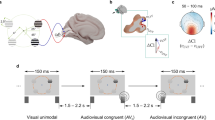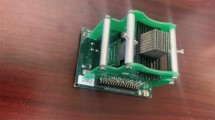Abstract
When the brain is deprived of input from one sensory modality, it often compensates with supranormal performance in one or more of the intact sensory systems. In the absence of acoustic input, it has been proposed that cross-modal reorganization of deaf auditory cortex may provide the neural substrate mediating compensatory visual function. We tested this hypothesis using a battery of visual psychophysical tasks and found that congenitally deaf cats, compared with hearing cats, have superior localization in the peripheral field and lower visual movement detection thresholds. In the deaf cats, reversible deactivation of posterior auditory cortex selectively eliminated superior visual localization abilities, whereas deactivation of the dorsal auditory cortex eliminated superior visual motion detection. Our results indicate that enhanced visual performance in the deaf is caused by cross-modal reorganization of deaf auditory cortex and it is possible to localize individual visual functions in discrete portions of reorganized auditory cortex.
This is a preview of subscription content, access via your institution
Access options
Subscribe to this journal
Receive 12 print issues and online access
$209.00 per year
only $17.42 per issue
Buy this article
- Purchase on Springer Link
- Instant access to full article PDF
Prices may be subject to local taxes which are calculated during checkout







Similar content being viewed by others
References
Neville, H.J. & Lawson, D. Attention to central and peripheral visual space in a movement detection task: an event-related potential and behavioral study. II. Congenitally deaf adults. Brain Res. 405, 268–283 (1987).
Rauschecker, J.P. Compensatory plasticity and sensory substitution in the cerebral cortex. Trends Neurosci. 18, 36–43 (1995).
Lessard, N., Paré, M., Lepore, F. & Lassonde, M. Early-blind human subjects localize sound sources better than sighted subjects. Nature 395, 278–280 (1998).
Röder, B. et al. Improved auditory spatial tuning in blind humans. Nature 400, 162–166 (1999).
Sadato, N. et al. Activation of the primary visual cortex by Braille reading in blind subjects. Nature 380, 526–528 (1996).
Weeks, R. et al. A positron emission tomographic study of auditory localization in the congenitally blind. J. Neurosci. 20, 2664–2672 (2000).
Ptito, M., Moesgaard, S.M., Gjedde, A. & Kupers, R. Cross-modal plasticity revealed by electrotactile stimulation of the tongue in the congenitally blind. Brain 128, 606–614 (2005).
Bavelier, D., Dye, M.W.G. & Hauser, P.C. Do deaf individuals see better? Trends Cogn. Sci. 10, 512–518 (2006).
Nishimura, H. et al. Sign language 'heard' in the auditory cortex. Nature 397, 116 (1999).
Petitto, L.A. et al. Speech-like cerebral activity in profoundly deaf people processing signed languages: implications for the neural basis of human language. Proc. Natl. Acad. Sci. USA 97, 13961–13966 (2000).
Finney, E.M., Fine, I. & Dobkins, K.R. Visual stimuli activate auditory cortex in the deaf. Nat. Neurosci. 4, 1171–1173 (2001).
Bavelier, D. & Neville, H.J. Cross-modal plasticity: where and how? Nat. Rev. Neurosci. 3, 443–452 (2002).
Kral, A. et al. Cochlear implants: cortical plasticity in congenital deprivation. Prog. Brain Res. 157, 283–313 (2006).
Pasternak, T. & Merigan, W.H. Movement detection by cats: invariance with direction and target configuration. J. Comp. Physiol. Psychol. 94, 943–952 (1980).
Lomber, S.G., Payne, B.R. & Horel, J.A. The cryoloop: An adaptable reversible cooling deactivation method for behavioral and electrophysiological assessment of neural function. J. Neurosci. Methods 86, 179–194 (1999).
Malhotra, S. & Lomber, S.G. Sound localization during homotopic and heterotopic bilateral cooling deactivation of primary and nonprimary auditory cortical areas in the cat. J. Neurophysiol. 97, 26–43 (2007).
Malhotra, S., Stecker, G.C., Middlebrooks, J.C. & Lomber, S.G. Sound localization deficits during reversible deactivation of primary auditory cortex and/or the dorsal zone. J. Neurophysiol. 99, 1628–1642 (2008).
Lomber, S.G. & Malhotra, S. Double dissociation of 'what' and 'where' processing in auditory cortex. Nat. Neurosci. 11, 609–616 (2008).
He, J., Hashikawa, T., Ojima, H. & Kinouchi, Y. Temporal integration and duration tuning in the dorsal zone of cat auditory cortex. J. Neurosci. 17, 2615–2625 (1997).
Stecker, G.C., Harrington, I.A., Macpherson, E.A. & Middlebrooks, J.C. Spatial sensitivity in the dorsal zone (area DZ) of cat auditory cortex. J. Neurophysiol. 94, 1267–1280 (2005).
Carrasco, A. & Lomber, S.G. Evidence for hierarchical processing in cat auditory cortex: nonreciprocal influence of primary auditory cortex on the posterior auditory field. J. Neurosci. 29, 14323–14333 (2009).
Reale, R.A. & Imig, T.J. Tonotopic organization in auditory cortex of the cat. J. Comp. Neurol. 192, 265–291 (1980).
Palmer, L.A., Rosenquist, A.C. & Tusa, R.J. The retinotopic organization of lateral suprasylvian visual areas in the cat. J. Comp. Neurol. 177, 237–256 (1978).
Middlebrooks, J.C. & Zook, J.M. Intrinsic organization of the cat's medial geniculate body identified by projections to binaural response–specific bands in the primary auditory cortex. J. Neurosci. 1, 203–224 (1983).
Knight, P.L. Representation of the cochlea within the anterior auditory field (AAF) of the cat. Brain Res. 130, 447–467 (1977).
Yang, X.F., Kennedy, B.R., Lomber, S.G., Schmidt, R.E. & Rothman, S.M. Cooling produces minimal neuropathology in neocortex and hippocampus. Neurobiol. Dis. 23, 637–643 (2006).
Bavelier, D. et al. Visual attention to the periphery is enhanced in congenitally deaf individuals. J. Neurosci. 20, RC93 (2000).
Voss, P., Gougoux, F., Zattore, R.J., Lassonde, M. & Lepore, F. Differential occipital responses in early- and late-blind individuals during a sound discrimination task. Neuroimage 40, 746–758 (2008).
Winters, B.D., Forwood, S.E., Cowell, R.A., Saksida, L.M. & Bussey, T.J. Double dissociation between the effects of peri-postrhinal cortex and hippocampal lesions on tests of object recognition and spatial memory: heterogeneity of function within the temporal lobe. J. Neurosci. 24, 5901–5908 (2004).
Collignon, O., Voss, P., Lassonde, M. & Lepore, F. Cross-modal plasticity for the spatial processing of sounds in visually deprived subjects. Exp. Brain Res. 192, 343–358 (2009).
Merabet, L.B. & Pascual-Leone, A. Neural reorganization following sensory loss: the opportunity of change. Nat. Rev. Neurosci. 11, 44–52 (2010).
Kral, A., Schröder, J.H., Klinke, R. & Engel, A.K. Absence of cross-modal reorganization in the primary auditory cortex of congenitally deaf cats. Exp. Brain Res. 153, 605–613 (2003).
Stewart, D.L. & Starr, A. Absence of visually influenced cells in auditory cortex of normal and congenitally deaf cats. Exp. Neurol. 28, 525–528 (1970).
Auer, E.T. Jr., Bernstein, L.E., Sunkarat, W. & Singh, M. Vibrotactile activation of the auditory cortices in deaf versus hearing adults. Neuroreport 18, 645–648 (2007).
Bross, M. Residual sensory capacities of the deaf: a signal detection analysis of a visual discrimination task. Percept. Mot. Skills 48, 187–194 (1979).
Finney, E.M. & Dobkins, K.R. Visual contrast sensitivity in deaf versus hearing populations: exploring the perceptual consequences of auditory deprivation and experience with a visual language. Brain Res. Cogn. Brain Res. 11, 171–183 (2001).
Reynolds, H.N. Effects of foveal stimulation on peripheral visual processing and laterality in deaf and hearing subjects. Am. J. Psychol. 106, 523–540 (1993).
Brozinsky, C.J. & Bavelier, D. Motion velocity thresholds in deaf signers: changes in lateralization, but not in overall sensitivity. Brain Res. Cogn. Brain Res. 21, 1–10 (2004).
Bosworth, R.G. & Dobkins, K.R. The effects of spatial attention on motion processing in deaf signers, hearing signers and hearing nonsigners. Brain Cogn. 49, 152–169 (2002).
Lomber, S.G. Behavioral cartography of visual functions in cat parietal cortex: areal and laminar dissociations. Prog. Brain Res. 134, 265–284 (2001).
Sur, M., Garraghty, P.E. & Roe, A.W. Experimentally induced visual projections into auditory thalamus and cortex. Science 242, 1437–1441 (1988).
Heid, S., Hartmann, R. & Klinke, R. A model for prelingual deafness, the congenitally deaf white cat—population statistics and degenerative changes. Hear. Res. 115, 101–112 (1998).
Kral, A., Hartmann, R., Tillein, J., Heid, S. & Klinke, R. Hearing after congenital deafness: central auditory plasticity and sensory deprivation. Cereb. Cortex 12, 797–807 (2002).
Levick, W.R., Thibos, L.N. & Morstyn, R. Retinal ganglion cells and optic decussation of white cats. Vision Res. 20, 1001–1006 (1980).
Guillery, R.W., Hickey, T.L. & Spear, P.D. Do blue-eyed white cats have normal or abnormal retinofugal pathways? Invest. Ophthalmol. Vis. Sci. 21, 27–33 (1981).
Berkley, M.A. Visual discriminations in the cat. in Animal Psychophysics: the Design and Conduct of Sensory Experiments (ed. W. Stebbins) 231–247 (Appleton Century-Crofts, New York, 1970).
Lomber, S.G. & Payne, B.R. Task-specific reversal of visual hemineglect following bilateral reversible deactivation of posterior parietal cortex: a comparison with deactivation of the superior colliculus. Vis. Neurosci. 18, 487–499 (2001).
Levitt, H. Transformed up-down methods in psychoacoustics. J. Acoust. Soc. Am. 49, 467–477 (1971).
Hall, S.E. & Mitchell, D.E. Grating acuity of cats measured with detection and discrimination tasks. Behav. Brain Res. 44, 1–9 (1991).
Mellott, J.G. et al. Areas of the cat auditory cortex as defined by neurofilament proteins expressing SMI-32. Hear. Res. 267, 119–136 (2010).
Acknowledgements
We thank B.D. Corneil, M.A. Goodale, W.A. Roberts, D.F. Sherry, B. Timney and J. Snow for helpful discussions and comments on the project and manuscript. We thank A.J. McMillan and A. Carrasco for preparing all of the figures and for help with the preparation of the manuscript. We also thank A.J. McMillan for assistance with the fabrication of the cooling loops, surgical implantations and care of the animals. J.G. Mellott graciously assisted with the histological processing of the brains. We gratefully acknowledge the support of the Canadian Institutes of Health Research, Natural Sciences and Engineering Research Council of Canada, Deutsche Forschungsgemeinschaft and the US National Institutes of Health.
Author information
Authors and Affiliations
Contributions
S.G.L. and A.K. conceived and designed the project. A.K. bred and provided the cats. All psychophysical work was performed or supervised by S.G.L. M.A.M. provided assistance with data analysis and interpretation. The manuscript was written and edited by all of the authors.
Corresponding author
Ethics declarations
Competing interests
The authors declare no competing financial interests.
Supplementary information
Supplementary Text and Figures
Supplementary Figures 1–6 (PDF 1914 kb)
Rights and permissions
About this article
Cite this article
Lomber, S., Meredith, M. & Kral, A. Cross-modal plasticity in specific auditory cortices underlies visual compensations in the deaf. Nat Neurosci 13, 1421–1427 (2010). https://doi.org/10.1038/nn.2653
Received:
Accepted:
Published:
Issue Date:
DOI: https://doi.org/10.1038/nn.2653
This article is cited by
-
Decoding auditory deprivation: resting-state fMRI insights into deafness and brain plasticity
Brain Structure and Function (2024)
-
Evidence of visual crossmodal reorganization positively relates to speech outcomes in cochlear implant users
Scientific Reports (2022)
-
Central auditory deficits associated with genetic forms of peripheral deafness
Human Genetics (2022)
-
Cochlear Implant Research and Development in the Twenty-first Century: A Critical Update
Journal of the Association for Research in Otolaryngology (2021)
-
Development of Auditory Cortex Circuits
Journal of the Association for Research in Otolaryngology (2021)



